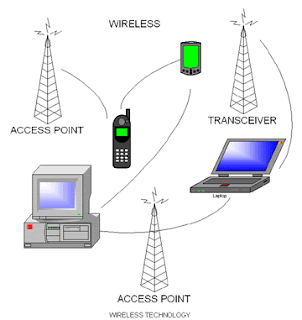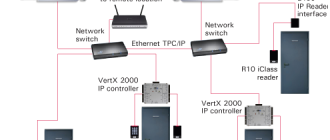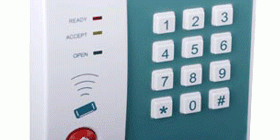
The pros and cons of wireless access control systems
Wireless access control systems have become increasingly popular in recent years, as they offer a range of benefits and conveniences over traditional wired systems. These systems allow for flexibility and ease of installation, making them ideal for both residential and commercial applications.
One of the main pros of wireless access control systems is their flexibility. With wireless systems, there are no limitations on the placement of control panels and readers, allowing for easy customization to suit the needs of the user. This means that access points can be easily added or relocated as needed, without the need for complicated wiring or infrastructure changes.
Another advantage of wireless access control systems is their convenience. With a wireless system, users can control access to their premises from anywhere, using a smartphone or other mobile device. This means that authorized individuals can grant or revoke access remotely, without the need for physical keys or proximity cards.
However, it’s important to consider the cons of wireless access control systems as well. One potential disadvantage is the risk of signal interference or hacking. While modern wireless systems are typically secure and encrypted, there is always a small chance that a skilled hacker could gain access to the system and compromise security.
In conclusion, wireless access control systems offer a range of benefits, including flexibility and convenience. However, it’s important to carefully consider the potential security risks before implementing such a system.
Benefits of Wireless Access Control Systems
Wireless access control systems offer numerous advantages over traditional wired systems. Here are some of the key benefits:
| 1. Flexibility: | 1. Limited range: |
| Wireless access control systems provide greater flexibility in terms of installation. Unlike wired systems, which require extensive wiring, wireless systems can be installed quickly and easily, making them ideal for retrofitting in existing buildings or areas where running cables is impractical. | One of the main drawbacks of wireless access control systems is their limited range. As they rely on wireless signals, the range can be affected by obstacles such as walls and interference from other devices. This means that in larger buildings or areas with many obstructions, additional equipment or repeaters may be necessary to ensure reliable coverage. |
| 2. Scalability: | 2. Vulnerability to hacking: |
| Wireless systems are highly scalable, allowing for easy expansion or modification of the system as the needs of the building change. New doors and readers can be added without the need for additional wiring, making it a cost-effective solution for businesses. | While wireless access control systems offer convenience, they can also be vulnerable to hacking. Without proper security measures in place, wireless signals can be intercepted or manipulated, potentially compromising the security of the system. It is crucial to implement encryption and other security measures to protect against unauthorized access. |
| 3. Convenience: | 3. Reliability: |
| Wireless access control systems provide convenience for users. Employees can use their smartphones or other wireless devices as credentials, eliminating the need for physical keys or access cards. This enhances convenience and simplifies access management. | While wireless access control systems offer convenience, they can be less reliable than wired systems. Wireless signals can be affected by environmental factors, leading to intermittent or slow connections. It is essential to ensure a stable and reliable wireless network to maintain the performance of the system. |
In conclusion, wireless access control systems offer flexibility, scalability, and convenience, making them a popular choice for businesses. However, their limited range, vulnerability to hacking, and reliance on a reliable wireless network are drawbacks to consider. Proper planning and implementation of security measures can help mitigate these concerns.
Convenience and Flexibility
Wireless access control systems offer numerous advantages when it comes to convenience and flexibility. With wireless technology, users can access control systems without the need for physical wired connections, allowing for greater mobility and ease of use.
One of the main advantages of wireless access control systems is their ability to provide remote access capabilities. This means that users can control and manage access to a building or space from anywhere, as long as they have a wireless connection. This flexibility is especially beneficial for businesses and organizations with multiple locations or remote teams.
Wireless access control systems also offer the convenience of easy installation and scalability. Unlike traditional wired systems, which require extensive planning and wiring, wireless systems can be quickly installed and expanded as needed. This allows for faster implementation and reduces disruption to the existing infrastructure.
Another advantage is the added convenience of using mobile devices for access control. With wireless systems, users can use their smartphones or tablets to gain access, eliminating the need for physical keys or access cards. This not only simplifies the process but also adds an extra layer of security, as mobile devices can be easily tracked and disabled if lost or stolen.
Despite these advantages, it’s worth noting that wireless access control systems also have their drawbacks. Interference from other wireless devices and potential security vulnerabilities can pose challenges. However, with proper implementation and security protocols in place, these disadvantages can be mitigated.
In conclusion, wireless access control systems offer convenience and flexibility, allowing for remote access, easy installation, and the use of mobile devices. While there may be some drawbacks, the pros outweigh the cons, making wireless control systems an attractive option for many businesses and organizations.
Easy Installation
One of the main advantages of wireless access control systems is their easy installation.
Traditional access control systems often require extensive wiring and infrastructure to be installed, which can be time-consuming and expensive. Wireless access control systems, on the other hand, eliminate the need for complex wiring and can be easily installed and set up in a matter of hours.
This simplifies the installation process and reduces the disruption caused by installation work. It also allows for flexibility in the placement of access control devices, as they can be easily moved or relocated without the need for additional wiring.
| Pros | Cons |
|
|
Scalability and Cost-Effectiveness
One of the major advantages of wireless access control systems is their scalability and cost-effectiveness. These systems can easily accommodate a large number of users and access points, making them ideal for businesses of all sizes.
Traditional access control systems require extensive wiring and infrastructure to connect each access point, which can be time-consuming and costly. In contrast, wireless access control systems eliminate the need for wiring, allowing for a more flexible installation process and reducing installation costs.
Wireless access control systems also offer the ability to easily add or remove access points as needed, without the need for rewiring or reconfiguring the entire system. This scalability makes it convenient for businesses that may need to expand or rearrange their physical space over time.
Furthermore, wireless access control systems often come with advanced features such as remote management and monitoring capabilities. This allows administrators to manage the system from a central location, reducing the need for on-site personnel and further contributing to cost savings.
In addition, wireless access control systems are often compatible with a variety of devices such as smartphones and tablets, allowing for a more convenient and flexible user experience. This compatibility can also contribute to cost savings, as businesses can leverage existing devices rather than investing in specialized hardware.
Overall, the scalability and cost-effectiveness of wireless access control systems make them a popular choice for businesses looking for a flexible, efficient, and affordable solution for controlling access to their premises.
Remote Access and Monitoring
One of the significant benefits of wireless access control systems is the ability to remotely access and monitor them. This feature allows authorized individuals to control the system from anywhere with an internet connection, making it convenient and flexible for users.
With remote access, administrators can manage access rights, grant or revoke permissions, and monitor activity in real-time. This level of control enhances security by enabling prompt actions if any unauthorized access or suspicious activity is detected.
Another advantage of remote access and monitoring is the ability to receive instant alerts and notifications. Administrators can set up email notifications or push notifications to their mobile devices, enabling them to respond quickly to security events or issues.
Additionally, remote access allows for easier system management and maintenance. Firmware updates and configuration changes can be done remotely, eliminating the need for physical access to the control panel or devices. This saves time, reduces costs, and minimizes disruptions to the overall system.
However, it is important to note that remote access and monitoring can also present some risks. If not properly secured, wireless access control systems may be vulnerable to hacking or unauthorized access. It is crucial to implement robust security measures, such as encryption protocols and strong access controls, to protect the system from potential threats.
In conclusion, remote access and monitoring are valuable features of wireless access control systems, offering convenience, flexibility, and improved security. However, proper security measures must be in place to ensure the integrity and confidentiality of the system.
Challenges of Wireless Access Control Systems
While wireless access control systems can provide numerous advantages, they are not without their challenges and drawbacks. It is important to consider these cons when implementing such systems:
- Reliability: One of the main challenges of wireless access control systems is their reliability. As wireless signals can be affected by various environmental factors, such as interference from other devices or physical obstacles, there is a risk of system failures or interruptions in communication.
- Security: Wireless access control systems are susceptible to security breaches. Hackers can potentially intercept and manipulate wireless signals, allowing unauthorized access to the system. It is crucial to implement strong encryption protocols and regularly update security measures to mitigate these risks.
- Scalability: Scaling up a wireless access control system can be complex and costly. Adding new devices or expanding coverage areas may require significant infrastructure changes, such as installing additional access points or repeaters. Planning for future scalability is essential to avoid potential limitations or disruptions.
- Battery Life: Most wireless access control devices are battery-powered. Therefore, managing battery life becomes an important consideration. Regular monitoring and maintenance of batteries are necessary to ensure uninterrupted functionality of the system. Additionally, battery replacement or recharging can incur additional costs and efforts.
- Compatibility: Compatibility issues can arise when integrating wireless access control systems with existing infrastructure or devices. Different wireless protocols, frequencies, or network standards may not be compatible with each other, requiring additional equipment or modifications to ensure smooth integration.
- Maintenance and Support: Maintaining and supporting wireless access control systems can be challenging. Regular firmware updates, network troubleshooting, and device maintenance are necessary to ensure ongoing performance and reliability. IT staff or specialized knowledge may be required to handle these tasks.
By considering and addressing these challenges, organizations can successfully implement and manage wireless access control systems to enhance security and convenience.
Reliability and Security Concerns
One of the pros of wireless access control systems is their convenience and flexibility. With wireless technology, users can access the system from anywhere within its range without the need for physical keys. This can be especially beneficial for businesses with multiple entry points or for people who frequently move between different locations.
However, there are also cons to consider when it comes to wireless access control. One major concern is the reliability of the system. Wireless signals can be affected by various external factors, such as environmental conditions or interference from other devices. This can result in a loss of connectivity or delays in accessing the system, which can be frustrating and inconvenient for users.
Additionally, security is a significant concern with wireless access control. Since the system relies on wireless signals, there is a risk of unauthorized access or interception of the signal. Hackers or malicious individuals may attempt to exploit vulnerabilities in the system to gain entry or steal sensitive information. This highlights the need for robust security measures, such as encryption and authentication protocols, to safeguard against potential threats.
In order to address these concerns, it is important to choose a reliable and secure wireless access control system. This may involve investing in high-quality equipment, regularly updating software and firmware, and implementing strong security measures. Regular monitoring and maintenance are also essential to ensure the system remains secure and reliable over time.
| Convenience and flexibility | Potential reliability issues |
| Ability to access from anywhere within range | Security vulnerabilities |
| Useful for businesses with multiple entry points | Risk of unauthorized access or interception |
Interference and Range Limitations
One of the disadvantages of wireless access control systems is the issue of interference and range limitations. Given that wireless systems rely on a communication signal to transmit data, they are vulnerable to interference from other devices or obstacles that may hinder the signal strength or quality.
Interference can come from various sources, such as other wireless devices operating on the same frequency, electromagnetic interference from nearby equipment, or physical obstacles like walls and metal objects. This can lead to signal degradation or loss, resulting in unreliable communication between the control panel and the wireless access points.
Additionally, wireless access control systems have range limitations, meaning that the signal strength decreases as the distance between the control panel and the access points increases. This can pose challenges in larger or multi-story buildings where the control panel may be located far away from certain access points.
Despite these limitations, wireless access control systems have their advantages. They offer more flexibility and convenience compared to traditional wired systems, allowing for easier installation and scalability. The absence of physical wires also eliminates the need for extensive cabling, reducing installation costs and the potential for damage to existing structures.
However, it is important for organizations to consider these interference and range limitations when implementing wireless access control systems. Proper planning and positioning of access points, as well as continuous monitoring of signal strength and quality, can help mitigate these issues and ensure the reliability and effectiveness of the system.
Dependency on Power and Batteries
One of the pros of wireless access control systems is their ability to function without a physical connection to power sources. Traditional access control systems often require the installation of wires and cables to connect the devices to a power supply. In contrast, wireless systems operate using battery power, eliminating the need for intricate wiring.
This means that wireless access control systems can be installed in areas where it is difficult or impractical to run cables, such as historic buildings or remote locations. It also allows for easy installation and scalability, as devices can be placed wherever needed without the constraints of wired connections.
On the other hand, the dependency on power and batteries can be considered a drawback of wireless access control systems. The batteries powering the devices need to be regularly maintained and replaced to ensure uninterrupted operation. This can be a time-consuming and costly task, especially in large-scale systems with numerous devices.
Additionally, if the batteries of the wireless access control devices are not adequately monitored or maintained, they can run out of power, leading to a loss of control or security breaches. It is crucial to establish a proper maintenance schedule and backup power solutions to prevent such situations.
Overall, while wireless access control systems offer flexibility and easy installation, their dependency on power and batteries requires diligent maintenance and monitoring to ensure reliable and uninterrupted operation.
Comparison with Wired Systems
When comparing wireless access control systems with their wired counterparts, it is important to consider the pros and cons of each.
| Pros | Pros |
| 1. Easy Installation: Wireless systems are generally easier to install as they do not require extensive wiring. | 1. Stability: Wired systems are known for their stability and reliability, as there are no potential issues with wireless signals. |
| 2. Flexibility: Wireless systems offer more flexibility in terms of where access control devices can be installed, as they are not limited by wiring constraints. | 2. Enhanced Security: Wired systems are more secure as they are not susceptible to hacking or signal interference. |
| 3. Scalability: Wireless systems are easier to expand and modify, as there is no need to lay additional cables. | 3. Cost-effective: Wired systems are generally more cost-effective in the long run, as they do not require batteries or regular maintenance. |
Cons
- 1. Wireless systems may be more susceptible to signal interference or hacking attempts.
- 2. They may require regular maintenance and battery replacements.
- 3. Wireless systems may have limited range compared to wired systems.
- 4. Wired systems may be more difficult and time-consuming to install due to the need for extensive wiring.
In conclusion, both wireless and wired access control systems have their respective advantages and disadvantages. It is important to carefully evaluate the specific needs and requirements of a facility before deciding which type of system to implement.
Flexibility and Mobility
One of the main advantages of wireless access control systems is their flexibility and mobility. With a wireless system, users can easily move around and access the controlled areas without being limited by physical cables or connections.
This flexibility allows for easier installation and reconfiguration of the access control system. Unlike wired systems, wireless systems do not require extensive wiring work and can be easily installed and set up in various locations. This can be particularly beneficial in situations where a traditional wired system would be impractical or too expensive to install.
In addition, wireless access control systems provide greater mobility for users. Users can carry wireless access credentials with them, such as key fobs or access cards, and easily gain access to controlled areas by simply presenting their credentials to the wireless reader. This eliminates the need for physical keys or passcodes, making the access process more convenient and efficient.
However, it’s important to note that there are some drawbacks to wireless systems as well. For instance, wireless systems can be susceptible to interference or hacking attempts, which can compromise the security of the access control system. Additionally, wireless systems may require more frequent maintenance and monitoring to ensure proper functionality.
In summary, the flexibility and mobility provided by wireless access control systems have numerous benefits. They allow for easy installation and reconfiguration, as well as convenient access for users. However, they also come with potential security and maintenance concerns that must be addressed to ensure the effectiveness and reliability of the system.
Installation and Maintenance
When it comes to the installation and maintenance of wireless access control systems, there are both pros and cons to consider.
One of the main advantages of wireless access control systems is the ease of installation. Unlike traditional wired systems, wireless systems don’t require the installation of cables and wires throughout a building. This makes the installation process much quicker and less disruptive. Additionally, wireless systems are more flexible and can be easily expanded or modified if needed.
However, there are also some drawbacks to wireless systems when it comes to maintenance. Wireless systems may require regular battery replacements, depending on the type of devices used. This can add to the overall maintenance cost and effort. Additionally, wireless systems may be more susceptible to interference from other wireless devices, which can affect their performance and reliability.
Overall, the installation and maintenance of wireless access control systems offer several benefits, such as easy installation and flexibility. However, it’s important to consider the potential maintenance requirements and possible interference issues when choosing a wireless system.
Cost and Scalability
One of the key advantages of wireless access control systems is their cost-effectiveness and scalability.
When compared to traditional wired systems, wireless access control systems tend to be more affordable, as they eliminate the need for extensive cabling and wiring installations. This not only saves on installation costs but also reduces the overall time and effort required for system setup.
Additionally, wireless access control systems offer a high level of scalability. They can easily accommodate an increasing number of users, doors, or access points without the need for major infrastructure upgrades. This scalability makes wireless systems suitable for both small-scale applications, such as homes or small offices, as well as large-scale deployments, such as commercial buildings or campuses.
However, it is important to consider some potential drawbacks of wireless access control systems. One of the main cons is that wireless systems may experience signal interference or limited range in certain environments, such as dense urban areas or buildings with thick walls. These factors can impact the reliability and performance of the system.
Another potential disadvantage is the reliance on batteries for wireless components. Unlike wired systems that are powered by a constant electrical supply, wireless devices require regular battery replacement or recharging. This ongoing maintenance requirement may add to the overall costs and inconvenience of the system.
In summary, wireless access control systems offer cost savings and scalability advantages over traditional wired systems. However, potential signal interference and battery reliance should be taken into consideration when evaluating the suitability of wireless systems for a specific application.
Integration with Other Security Systems
One of the key advantages of wireless access control systems is their ability to integrate with other security systems. This integration allows for a more comprehensive and cohesive approach to security, as various systems can work together to provide a more robust and efficient solution.
One of the major pros of integrating wireless access control systems with other security systems is the increased level of access control it provides. By combining access control with other security measures, such as CCTV cameras or alarm systems, organizations can enhance their overall security posture. For example, if an unauthorized person attempts to gain access to a restricted area, the access control system can trigger an alarm, alerting security personnel and activating the surveillance cameras for immediate monitoring and response.
Additionally, integration with other security systems can provide improved situational awareness. By linking access control systems to video surveillance or intrusion detection systems, security personnel can have a real-time visual of who is entering or leaving a facility, enabling them to quickly identify potential security threats or breaches. This real-time information allows for a faster response time in case of emergencies or security incidents.
However, just like any other system, there are also cons to consider when integrating wireless access control systems with other security systems. One drawback is the potential for increased complexity. Integration requires compatibility between different systems and may involve additional setup and configuration. This can increase the overall complexity of the security infrastructure and may require additional training for security personnel to effectively manage and operate the integrated systems.
Another disadvantage is the potential for increased vulnerability. Integrating wireless access control systems with other security systems means that any vulnerabilities in one system can potentially impact the overall security of the integrated solution. Therefore, it is essential to regularly assess and update the security measures of all integrated systems to ensure their effectiveness and minimize the risk of exploit or compromise.
| Enhanced access control | Increased complexity |
| Improved situational awareness | Potential for increased vulnerability |
Q&A:
What are the advantages of wireless access control systems?
There are several advantages of wireless access control systems. First, they offer greater flexibility and convenience compared to traditional wired systems. Wireless systems can be easily installed and relocated, making them ideal for temporary events or quickly changing access needs. Additionally, wireless systems eliminate the need for extensive wiring, reducing installation costs and disruption to the building. Furthermore, wireless access control systems often integrate with other security solutions, such as surveillance cameras and alarms, providing a comprehensive security solution.
Are wireless access control systems secure?
Yes, wireless access control systems can be highly secure when properly implemented. Manufacturers invest significant resources in developing advanced encryption and authentication protocols to ensure that wireless signals cannot be intercepted or tampered with. However, it is essential to follow best practices when configuring wireless systems, such as using strong passwords and regularly updating firmware to address potential vulnerabilities.
Do wireless access control systems require regular maintenance?
While wireless access control systems generally require less maintenance than traditional wired systems, they still require regular upkeep. This includes monitoring the battery levels of wireless devices, checking for signal interference or weak spots in coverage, and applying firmware updates to address security vulnerabilities. Regular maintenance helps ensure the system operates reliably and securely.
What are the potential disadvantages of wireless access control systems?
Despite their numerous advantages, wireless access control systems do have some potential disadvantages. One drawback is the reliance on wireless signals, which can be prone to interference from other electronic devices or building materials. This interference can impact the reliability and range of the wireless system. Additionally, wireless systems may require more frequent battery replacements compared to wired systems, which can be an ongoing expense. Finally, the initial cost of wireless access control systems can be higher than traditional wired systems, although this cost gap continues to decrease as technology advances.
Can wireless access control systems be integrated with existing security systems?
Yes, wireless access control systems can often be integrated with existing security systems. Many manufacturers provide compatibility with common security protocols, allowing wireless access control systems to communicate with surveillance cameras, alarm systems, and other security devices. This integration enhances the overall security capabilities of the system and enables centralized management and monitoring of all security components.






